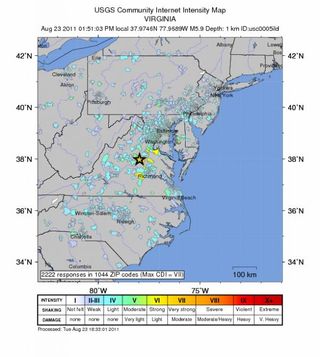
Irene Looming, Scientists Raced to Find Clues to the Big Eastern Earthquake

Any earthquake whose effects were as widespread as the one that rattled the East Coast on Aug. 23 demands investigation of the impacted area, but in this case, researchers faced a rare challenge Hurricane Irene, which made landfall Aug. 27 and meant scientists only had a matter of days before the storm's rains erased the evidence.
But even with this unusual challenge, investigators succeeded in quickly discovering key details about the quake's effects before the storm washed them away.
"We feel pretty good about what we were able to document in such a limited amount of time," said civil and environmental engineer James R. Martin II, director of the World Institute for Disaster Risk Management at Virginia Tech in Blacksburg.
Widespread shaking
The quake, centered near Mineral, Va., was a magnitude 5.8 East Coast event felt as far south as Georgia and as far north as Montreal. Damage from the earthquake was relatively light, but effects were nevertheless seen at two landmarks in Washington, the Washington Monument and the National Cathedral, with additional damage reports coming from as far away as New York City, about 320 miles (515 kilometers) north. The quake also triggered the shutdown of the nuclear reactors at the North Anna Power Plant located near the epicenter, in Louisa County, Va.
Although the quake was not expected to wreak significant damage, it is nonetheless important to carefully investigate what effects it had, Martin said.
"The quake perhaps was a preview of what damage pattern we can expect if we have as large an earthquake as is possible in this region," Martin told OurAmazingPlanet. For instance, "significant damage happened at Washington, D.C., even though it was more than 100 miles [160 km] from the epicentral region. We want to know precisely why that was."
Sign up for the Live Science daily newsletter now
Get the world’s most fascinating discoveries delivered straight to your inbox.
Moving fast
Martin was entrusted the day before the Irene's landfall with leading a team of U.S. scientists and engineers to investigate the quake's aftereffects. They had to move fast to take samples, create maps, and photograph damage to infrastructure and underground locations.
"The most pressing issue has been collecting perishable data ahead of Hurricane Irene ," Martin said.
The team's main focus was on river and stream deposits, which are typically the most vulnerable to impact from hurricanes and their accompanying flooding. They also researched "waterfront structures, bridges, dams and embankments, earth-retaining systems, monuments and institutions that were damaged, and critical facilities such as major airports and the power plant," Martin said. Soil and geological conditions also can shed light on damage patterns around the epicenter and in more distant locales, so they were important to take a look at before the storm hit.
In the end, "we feel we documented the most important findings, although minor features that may have been present along some rivers and streams may have been lost due to heavy rains and subsequent rises in rivers and streams," Martin said.
For instance, they found evidence the earthquake was large enough to cause liquefaction, essentially shaking the ground soupy. "In a big thunderstorm, this would have been washed away," Martin said.
Work to collect evidence from the earthquake is continuing after the hurricane. The researchers aim to have a preliminary report for the National Science Foundation within two or so weeks, with a more detailed analysis to follow in the next few months.
"Beyond technical findings, the event can also teach us much about the need for greater preparedness for and better awareness of eastern U.S. earthquake hazards ," he said. "Many communities, emergency centers, local governments and regional governments didn't really know what to do. They weren't prepared for this type of event."

